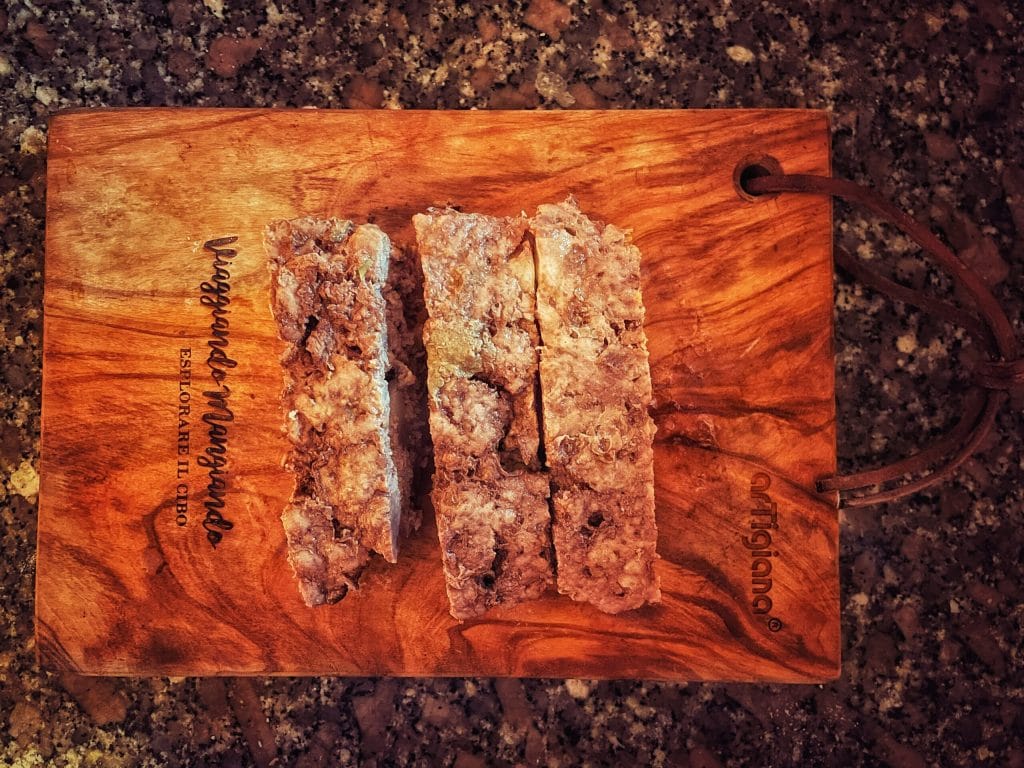The Leberkässemmel is the Bavarian and Austrian sandwich filled with a thick slice of leberkäse, pickled cucumbers, and sweet mustard.
In the Bavarian dialect group of the German-speaking area and in Austria, it’s usually referred to as Leberkässemmel, while in Franconia the terms “Leberkäsbrödle”, “Leberkäsweggla” or “Leberkäsweckla” “Leberkäswecken” “Leberkäswegga” are more common, often abbreviated as LKW.
The Leberkäse (literally liver cheese), also called Fleischkäse, is a meat dish typical of Bavaria, Baden-Württemberg, Switzerland, and Austria, and is very popular in the rest of Germany and all German-speaking populations, including South Tyrol.
Similar to a meatloaf, in Germany it is actually considered a Wurst, therefore classified as a sausage.
Made from beef, pork belly, water, onion, salt, and marjoram.
The ingredients are ground very finely and baked in a mold similar to that used for sandwich bread.
It can be sliced and served hot, browned in a pan with butter, in a kaisersemmel (a small, round, crispy roll with a star shape, originally from Austria), or eaten cold with bread, cucumbers, and mustard. In Bavaria, it is consumed along with weißwurst for breakfast.

- Difficulty: Medium
- Cost: Cheap
- Rest time: 30 Minutes
- Preparation time: 15 Minutes
- Cooking methods: Oven
- Cuisine: German
- Seasonality: All seasons
Ingredients for leberkäse (4 people)
- 1.1 lbs beef (flank)
- 7 oz fresh pork belly
- 1 onion
- 1.3 cups ice-cold water
- to taste marjoram
- to taste salt
- 1 kaiser roll
- to taste pickled cucumbers
- to taste sweet mustard
- to taste Bavarian butter
Tools
- 1 Mold sandwich bread
Steps
Combine the beef with the pork belly, add the onion, salt, marjoram, and water. Grind finely.
Leave the mixture in the fridge for 30 minutes.
Distribute it in a “sandwich bread” mold, smooth the surface, and draw a diamond grid pattern.
Bake in a static oven at 356°F for 1 hour.

For the Leberkässemmel:
Slice a thick piece of leberkäse, brown it in a pan with some butter.
Cut the roll in half, spread the sweet mustard, fill with the slice of leberkäse and pickled cucumbers.

Leberkässemmel in Munich
This is what we ate during our trip to Munich in September 2025.

FAQ (Frequently Asked Questions)
What is the origin and meaning of leberkäse?
It is said that Leberkäse was invented in 1776 by a butcher at the court of Charles Theodore of Wittelsbach, Elector Palatine, who brought it with him from Mannheim to Munich when he succeeded Maximilian III as Duke of Bavaria.
Literally translated, Leberkäse means “liver cheese”, but despite the name, there is no cheese or liver among the ingredients.
In Germany, for consumer protection reasons, Leberkäse must contain liver unless the name “Fleischkäse” (meatloaf) or “Bavarian Leberkäse” is used.
This occurs in most preparations.
In Austria, liver was added in the past, but today this is not a common practice.
Leber (liver) is probably, in this case, a corruption of laib (loaf of bread), due to the shape of the Leberkäse or it may also derive from the verb root lab, which in Middle High German stood for “curdle” or “coagulate”.
Kas is the Bavarian dialect term for an “edible mass”.
According to another explanation, the product’s shape resembles a cheese loaf (Käse laib) and käse could metaphorically indicate the cheese-like shape or, as some suggest, could derive from the root quas which in Slavic languages stands for “feast” or “banquet”.

